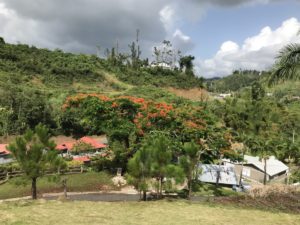In the assigned readings for this week, Mary MacDonald and Loida Martell present two different, yet related arguments to tease out the role that place play in the constitution of a sacred space.

Based on these two readings, you were asked to:
1. Reflect upon the two readings assigned for this week (MacDonald’s and Martell’s), and the class discussions about them.. In relation to the theme for this week, listed in the title of our portal here, write down (for you to have clear) the central arguments presented by Macdonald and Martell. Reflect a bit more on them.
2. Select a sentence or short passage from either one of the two assigned readings. Perform a close reading. To do that, find how the sentence selected illustrates the argument you have written above. How is that sentence or passage you have selected a mobilization, or poor use, of what evidence needed to prove the argument?
Please, post your reflection here at your earliest convenience. You do NOT have to rewrite anything, merely post it here so we can find it and read it with the remaining postings for this week.

Macdonald’s central argument in the introduction to Experiences of Place is that sacred spaces are more than just geographical locations tied to a spiritual history. They also have social, political, environmental, and personal importance that creates them. Martell’s central argument in her piece “My GPS Doesn’t Work in Puerto Rico” is that evangélica sacredness has been shaped by indigenous and colonial influences, and sacred spaces in evangélica are often communal and less rigid than its protestant counterparts. Both pieces imply that sacred space is created by the people that enter into it and consider it sacred.
“Place is not only a particular physical location, but also an idea, a mental construction which captures and directs the human relationship to the world.”
Experiences of Place, Macdonald, p. 2.
In this excerpt, Macdonald perfectly captures her argument that sacred spaces are constructed through more than just geography and history. Personal beliefs and human bonds create sacredness. She implies a level of spirituality, outside of structured religion, with the words “human relationship to the world.” She is stating humans could have a relationship, even an intimate relationship with the earth itself. This relationship is what creates the sacred.
Don Asafu-Adjaye
Tristen Kho
According to McDonalds, a sacred place can be any place, either manmade or natural, depending on its usage while Martell believes that sacred places are characterized by unity and freedom. Both authors believe, however, that sacred places can be more than just a place. In exploring the idea of sacred spaces, they first define what place means and how it contributes to the concept of sacred spaces. McDonalds explains the connection between place and the sacred by retelling a Papua New Guinean tale in which “[Mt.] Giluwe has his teeth smashed in by [Mt.] Sumale, resulting in his jagged appearance today.” This demonstrates that the physical geography of a place plays a big role in shaping the religious beliefs of the people in an area. Martell points out that a place is much more than just a place by incorporating personal anecdotes into her argument. During her visit to Puerto Rico, Martell found her GPS to be useless as these places did not exist according to this piece of technology. Rather she found places by asking locals about the physical landmarks and stories that the place tells. This shows that places are more than just a coordinate point on a map and can become sacred based on the meaning attributed to it.
On page 266 of “My Gps Does not Work In Puerto Rico,” Martell states, “In order to survive, and even to thrive under such dehumanizing conditions, evangélicas have shifted the notion of sacred space by creating new ones where they can experience presencia and vínculos that are life-giving for them.” In other words, because of the oppression evangelicas experience, they come together to create new spaces that brings them freedom. The author’s word choice in this reading starts off very unsettling. First off, Martell starts off this sentence in talking about the survival of the “evangelicas” which immediately brings attention to the seriousness of the matter she has yet to discuss. She then uses the word “dehumanizing” to characterize the evangelicas in order to draw attention to the constraints placed on the “evangelicas”. As a result of this constraint, the “evangelicas,” seek to create a new “sacred space” for themselves where they can live life without bounds placed upon them by society. With her word choice and description of the evangelicas, Martell makes it clear that the “evangelicas” are seeking freedom together in a new space.
The central arguments of MacDonald and Martell are similar in that they both acknowledge the importance of human involvement and recognition. They both realize that sacredness doesn’t need to be restrained to a single geographical or physical location or monument. Instead, they focus on the fact that community is what brings sacredness to a space. In the evangélica perspective, as pointed out by Martell, community and memories are what makes a place sacred (Martell 262). MacDonald also writes that the geographical place is less important than ‘the ritual events enacted there’ (MacDonald 9). In other words, one can find sacredness in each other every day because they are experiencing each other in spiritual ways. It does not need to be a specific, physical location for sacredness to be acknowledged or felt among a community of people.
In her argument, Martell emphasizes the importance of presence: ‘When we reprioritize place […] as sacred, that space where life is cherished and the expectation of an encounter between God, community, and the created world is honored, it seems to me that we allow breathing space to witness to God’s creativity in our midst: “behold, all things are made new” (270). Indeed, as Martell develops her argument about the evangélica perspective, she highlights a theory akin to the modern concept of mindfulness. We found this idea to be provocative as Martell supported this theory with everyday examples of sacred spaces. She argues that we should look up and be in the moment (presencia) and set aside the time. In being completely present, we can better participate in community and find connections to God.